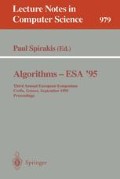Abstract
In the context of parallel computing, optical technology offers simple interconnection schemes with straightforward layouts that support complex logical interconnection patterns. The Passive Optical Star (Pos) is often suggested as a platform for implementing the optical network: logically it offers an all-to-all broadcast capability.
We investigate the self-simulation or scalability properties of the Pos. A family of parallel machines is said to be self-simulating or scalable if reducing the number of processors by a factor of k (by going to a smaller member of the family) increases the computation time by a factor of (the optimal) O(k).
We present a randomized algorithm for an n-processor Pos that simulates a kn-processor Pos with a slowdown of O(k+log* n) using local control only, thus coming close to the self-simulation ideal of O(k). We also analyze direct algorithms that send messages directly from their origin to their destination; for this case we prove that Θ(k 2) is the exact complexity.
This work was supported in part by ANM, C3, the French-Israeli grant for cooperation in Computer Science, by a grant from the Israeli Ministry of Science, and by the ESPRIT Basic Research Actions Program of the EU under contract No. 7141 (project ALCOM II).
Preview
Unable to display preview. Download preview PDF.
References
R.J. Anderson and G.L. Miller. Optical communication for pointer based algorithms. Technical Report CRI 88-14, Comp. Sci. Dept., USC, 1988.
R. Ballart and Y.C. Ching. SONET: Now It's the Standard Optical Network. IEEE Comm. Magazine, pages 8–15, March 1989.
H. Bast and T. Hagerup. Fast parallel space allocation, estimation and integer sorting (revised). Technical Report TR MPI-I-93-123, Max-Planck-Institut für Informatik, Saarbrücken, 1993.
P. Berthomé, Th. Duboux, T. Hagerup, I. Newman, and A. Schuster. Self-Simulation for the Passive Optical Star Model. Technical Report 95-13, LIP-ENS-Lyon, June 1995.
R. Cole. Parallel Merge Sort. SIAM J. Comput., 17(4):770–785, 1988.
T. Cox, F. Dix, C. Hemrick, and J. McRoberts. SMDS: The Beginning of WAN Superhighways. Data Communications, April 1991.
P.W. Dowd. Random Access Protocols for High-Speed Interprocessor Communication Based on an Optical Passive Star Topology. Journal of Ligthwave Technology, 9(6):799–808, June 1991.
L.A. Goldberg, M. Jerrum, T. Leighton, and S. Rao. A Doubly Logarithmic Communication Algorithm for the Completely Connected Optical Communication Parallel Computer. In Proc. 5th ACM SPAA, pages 300–309, June 1993.
L.A. Goldberg, M. Jerrum, and P.D. MacKenzie. An Ω(√log log n) Lower Bound for Routing in Optical Networks. In Proc. 6th ACM SPAA, pages 147–156, June 1994.
L.A. Goldberg, Y. Matias, and S. Rao. An Optical Simulation of Shared Memory. In Proc. 6th ACM SPAA, pages 257–267, June 1994.
G. Gravenstreter, R.G. Melhem, D.M. Chiarulli, S.P. Levitan, and J.P. Teza. The partitioned optical passive stars (pops) topology. In IPPS, 1995.
L. Lovász and M.D. Plummer. Matching theory. North Holland, Amsterdam, 1986.
J.M. Marberg and E. Gafni. Sorting in constant number of row and column phases on a mesh. Algorithmica, 3(4):561–572, 1988.
B. Mukherjee. WDM-Based Local Lightwave Networks Part I: Single-Hop Systems. IEEE Networks, pages 12–27, May 1992.
B. Mukherjee. WDM-Based Local Lightwave Networks Part II: Multi-Hop Systems. IEEE Networks, pages 20–32, July 1992.
R. Ramaswami. Multi-wavelength lightwave networks for computer communication. IEEE Comm. Magazine, 31:78–88, 1993.
Author information
Authors and Affiliations
Editor information
Rights and permissions
Copyright information
© 1995 Springer-Verlag Berlin Heidelberg
About this paper
Cite this paper
Berthomé, P., Duboux, T., Hagerup, T., Newman, I., Schuster, A. (1995). Self-simulation for the Passive Optical Star model. In: Spirakis, P. (eds) Algorithms — ESA '95. ESA 1995. Lecture Notes in Computer Science, vol 979. Springer, Berlin, Heidelberg. https://doi.org/10.1007/3-540-60313-1_156
Download citation
DOI: https://doi.org/10.1007/3-540-60313-1_156
Published:
Publisher Name: Springer, Berlin, Heidelberg
Print ISBN: 978-3-540-60313-9
Online ISBN: 978-3-540-44913-3
eBook Packages: Springer Book Archive

